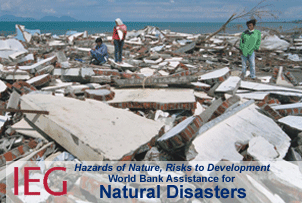USAID OFDA LAC Monthly Newsletters
In "Natural Disasters and Human Capital Appreciation" (World Bank Policy Research Working Paper 4862), Jesus Crespo Cuaresma empirically evaluates correlations between risk of natural disasters and levels of secondary education. Different theoretical models previously have predicted both positive correlations (because investments will be diverted from physical infrastructure that might be destroyed in a disaster) and negative correlations (because investment is less valuable if educated children might die in a disaster before their skills can be used. Cuaresma concludes that the observed correlation is negative, i.e., that disaster risk discourages investment in secondary education. "Our results give strong evidence of negative long‐run effects of geological natural disaster risk on secondary school enrollment rates. The effects are only present in the short and medium run to the extent that natural disasters cause instability and increase output volatility. The long‐run effects tend to be homogenous across countries and do not depend on income or the degree of human capital accumulation in the respective country. Furthermore, the political regime does not affect the disaster risk effect on human capital accumulation."
"Financing Recovery from Large-Scale Natural Disasters" by Rawle O. King (Congressional Research Service, RL34749, February 2009) reviews issues related to the capacity of the insurance industry to meet demand for natural disaster insurance. Although focused primarily on issues within the US, this CRS Report is a useful reference on data that insurers and re-insurers require about natural hazards and the financial tools that they offer to help mitigate risks when the required data are available.
Science and Tecnology for Sustainable Well-Being by John Holdren (Science, January 2008) is an adaptation of his address at the February 2007 meeting of the American Association for the Advancement of Science as outgoing president of the AAAS. In his address, Holdren advocated the use of science for international development. President-Elect Obama has announced that he intends to appoint Holdren as his science advisor, with the title of special advisor to the president, which is a higher-level appointment that President Bush's science advisor and effectively makes him the equivalent of a member of the President's cabinet.
Brenguier et al., 2008 describes how the cutting-edge seismological method of ambient noise tomography can measure stress relaxation on an active fault. It may be a good example of how modern seismological instrumentation, data management, and data analysis can contribute to improved hazard assessment.
On August 8, 2008, ICSU released "A Science Plan for Integrated Research on Disaster Risk: Addressing the challenge of natural and human-induced environmental hazards".
Among the projects funded by the World Bank's GFDRR for FY2008, one with many similarities to possible IRIS projects is "Climate Modeling and Risk Management", proposed by the WMO and endorsed by the Burundi representative to WMO. For this project, the WMO requested $473,000 to organize data and regional climate models for ten countries in the Greater Horn of Africa region and to carryout three workshops to train at least two people from each country in use of the climate models. The proposal promises to coordinate people developing the "National Adaptation Plan of Action" for climate change in each country, ensuring that this unusually science-oriented project actually contributes to disaster reduction. The project budget includes nine months of staff salary and overhead over the course of the 2.5 year project.
Brunnschweiler and Bulte, 2008 (Science, 320, 616-617) conclude that "Natural resources do not necessarily spell doom for development", contrarary to the "natural resources curse" hypothesized by many other economists investigating the causes of development failure and described in Paul Collier's popular book The Bottom Billion. Brunnschweiler and Bulte argue that the putative curse, based on negative correlations between economic growth and indices of resource flows, confuse cause and effect. In support of their interpretation, they demonstrate positive correlations between economic growth and World Bank measures of resource stocks, except for petroleum resources.
In March 2007, the Inter-American Development Bank published "From Disaster Response to Prevention", a background and context paper for new policy. The report noted that an emphasis on disaster response rather than prevention arises partly because "The Bank's practice is to respond to demands from its borrowing members". Nevertheless, the report identified "Support to country level hazard and vulnerability assessments, and risk monitoring" as one of five opportunities for action.
| Hazards of Nature, Risks to Development A report about the impact of natural hazards on World Bank development projects was published by the Bank's Independent Evaluation Group during 2006. The complete report is posted on a World Bank web page and the executive summary is posted here. The report's principal conclusions include that "[T]he equipment intended to help reduce vulnerability needs to be used effectively to achive its purpose; acquisition alone is not enough." |
 |
On October 11, 2006, the US State Department web site USINFO posted an article on the IRIS's long-term instrument loan program and AfricaArray. The article was distributed to all US Embassies around the world as part of the "Washington File".
EC project "Disaster Preparedness in the Himilayan Region"
| Rethinking Disasters from Oxfam, India The report urges more action to reduce the impact of natural disasters. The report includes some support for scientific infrastructure (e.g., page 21: "The first step towards risk reduction is knowing which hazards pose a threat. These must be analysed and the whole community brought together to understand the risks they face and also their vulnerabilities."). As suggested by the report's Figure 10 at the right, however seismologists involved in "monitoring and forecasting" or "teach and research" risk being seen as part of the problem if they fail to link their work sufficiently well to societal outcomes. |
 |
National Science and Technology Council Report on Grand Challenges for Disaster Reduction
GFZ International Training Courses on "Seismology and Seismic Hazard Assessment"(posted 2006 Aug 24)
The World Bank has prepared an indepdent evaluation of its own reponses to natural disasters.